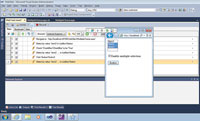Product Reviews
Comprehensive Testing with Telerik Test Studio
Test Studio brings together the tools to fully test your applications -- provided your team is willing to make the commitment to using it.
When "Shōgun" (Delacorte Press, 1975) surpassed 1,100 pages, someone observed that it wasn't a novel, it was a summer vacation. The same could be said about Telerik Test Studio because it's not just a tool -- it's a team commitment. Test Studio isn't a replacement for Visual Studio support for test-driven development. It's an integrated, standalone package that operates at a whole other level, assuming you want to go there -- and in a perfect world, you do.
Test Studio is aimed at small to mid-level shops, and despite the strong integration, it doesn't require Visual Studio. Be warned: This isn't a cheap package. At $2,500 per seat, you're not going to buy a license for every developer. Instead, you need someone in your team to be your test manager/Test Studio resource. In addition to buying Test Studio, you'll probably want the runtime version to use on test servers (at $199 each, the runtimes are relatively inexpensive). If you intend to do load testing (and, again, in a perfect world, you do), then you'll need a virtual user pack, but you'll have to call Telerik to get a quote on the price. Finally, if you're going to commit to Test Studio, you'll want to make sure that you're taking full advantage of it, so you'll also be interested in Telerik's training packages.
Well-Crafted UI
Fortunately, the well-crafted Test Studio UI reduces the barriers to entry in creating and managing tests. In Test Studio, you can start creating an automated Web, Windows Presentation Foundation (WPF) or load test with a right-click (manual tests are also integrated into the test plan). You can write your tests by specifying actions Web, WPF and load tests; or you can record your interactions with your application and save it as a test (your actions are tied to specific elements in your application's UI rather than mouse movements or keyboard navigation). For Web-based applications, you can import Fiddler logs to create a test.

[Click on image for larger view.] |
| Figure 1. To generate a functional test, start recording from within a Telerik Test project, navigate to
your Web page and work through your tests. |
The studio's integration of functional, load and performance tests will be attractive to shops already executing testing at the level that Test Studio assumes. Test Studio brings together a variety of tools that are often sold separately. You can, for instance, run your UI-based tests as load tests or performance tests. The range of application types covered is also attractive: WPF, ASP.NET and, in the mobile arena, iOS.
In addition to the standalone UI, the Test Studio suite includes a set of services that provide the input data for some of the tests. Test Studio also includes a Visual Studio plug-in and a set of templates for creating test projects. The integration with Visual Studio is good, allowing you to do your bug tracking either with Visual Studio Team Foundation Server or Telerik Team Pulse.
Like many developers, I'm suspicious of tools designed to support automated UI testing: the scripts for UI testing are often too complicated to maintain as applications evolve. The Telerik scripts, however, are tied to page elements rather than mouse movements. That should make your tests more resilient, provided you have the discipline and planning to avoid renaming your elements or drastically rearranging your UI. As I said, adopting a testing tool like this is as much about commitment as anything else.
Telerik Inc.
Web: telerik.com
Phone: 888-365-2779
Price: $2,499 for a single license with one year of upgrades and support
Quick Facts: A comprehensive test suite that covers UI, load and performance testing
Pros: A well-designed UI integrates the testing tools that mission-critical applications require
Cons: Unlike test-driven development, taking advantage of Test Studio requires a commitment from the organization and integration into the development process
About the Author
Peter Vogel is a system architect and principal in PH&V Information Services. PH&V provides full-stack consulting from UX design through object modeling to database design. Peter tweets about his VSM columns with the hashtag #vogelarticles. His blog posts on user experience design can be found at http://blog.learningtree.com/tag/ui/.